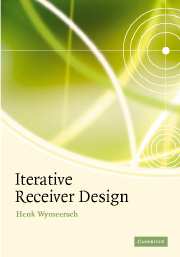Book contents
- Frontmatter
- Contents
- Preface
- Abbreviations
- Notations
- List of algorithms
- 1 Introduction
- 2 Digital communication
- 3 Estimation theory and Monte Carlo techniques
- 4 Factor graphs and the sum–product algorithm
- 5 Statistical inference using factor graphs
- 6 State-space models
- 7 Factor graphs in digital communication
- 8 Decoding
- 9 Demapping
- 10 Equalization–general formulation
- 11 Equalization: single-user, single-antenna communication
- 12 Equalization: multi-antenna communication
- 13 Equalization: multi-user communication
- 14 Synchronization and channel estimation
- 15 Appendices
- References
- Index
11 - Equalization: single-user, single-antenna communication
Published online by Cambridge University Press: 08 January 2010
- Frontmatter
- Contents
- Preface
- Abbreviations
- Notations
- List of algorithms
- 1 Introduction
- 2 Digital communication
- 3 Estimation theory and Monte Carlo techniques
- 4 Factor graphs and the sum–product algorithm
- 5 Statistical inference using factor graphs
- 6 State-space models
- 7 Factor graphs in digital communication
- 8 Decoding
- 9 Demapping
- 10 Equalization–general formulation
- 11 Equalization: single-user, single-antenna communication
- 12 Equalization: multi-antenna communication
- 13 Equalization: multi-user communication
- 14 Synchronization and channel estimation
- 15 Appendices
- References
- Index
Summary
Introduction
As depicted in Fig. 11.1, in single-user, single-antenna transmission, both the receiver and the transmitter are equipped with a single antenna. There are no other transmitters. This is the most conventional and well-understood way of communicating. Many receivers for such a set-up have been designed during the past few decades. These receivers usually consist of a number of stages. The first stage is a conversion from the continuous-time received waveform to a suitable observation (to allow digital signal processing), followed by equalization (to counteract inter-symbol interference), demapping (where decisions with respect to the coded bits are taken), and finally decoding (where we attempt to recover the original information sequence). This is a one-shot approach, whereby no information flows back from the decoder to the demapper or to the equalizer. Here the terms decoder, demapper, and equalizer pertain to the more conventional receiver tasks, not to nodes in any factor graph. In a conventional mind-set it is hard to come up with a non-ad-hoc way of exploiting information from the decoder during the equalization process. In the factor-graph framework, the flow of information between the various blocks appears naturally and explicitly. These two approaches to receiver design are depicted in Fig. 11.2.
In this chapter we will see how to convert the received waveform into a suitable observation y. This conversion is exactly the same as in conventional receivers.
- Type
- Chapter
- Information
- Iterative Receiver Design , pp. 207 - 216Publisher: Cambridge University PressPrint publication year: 2007



